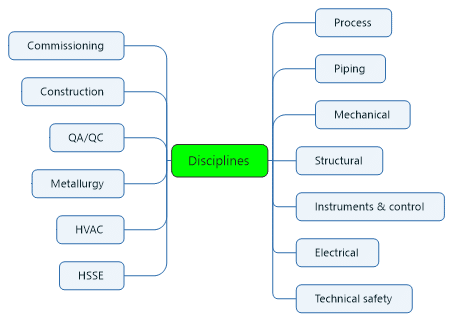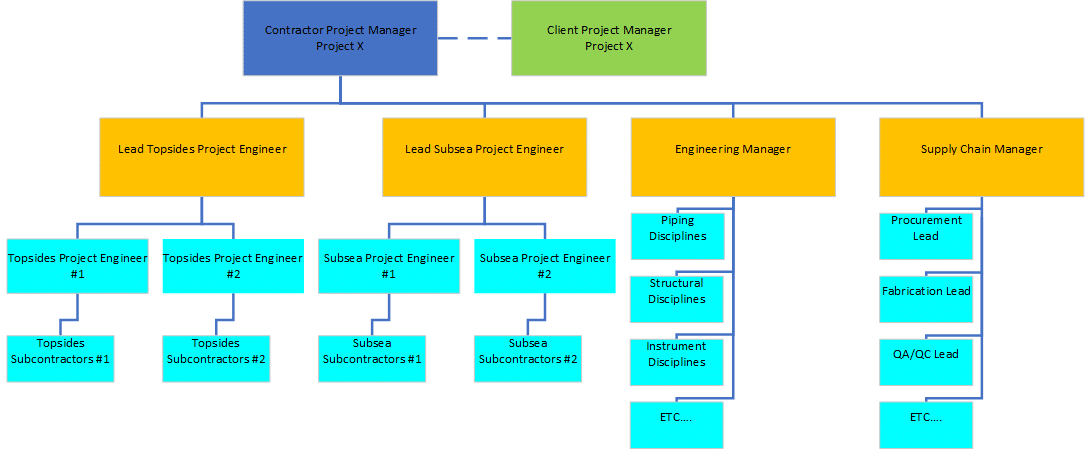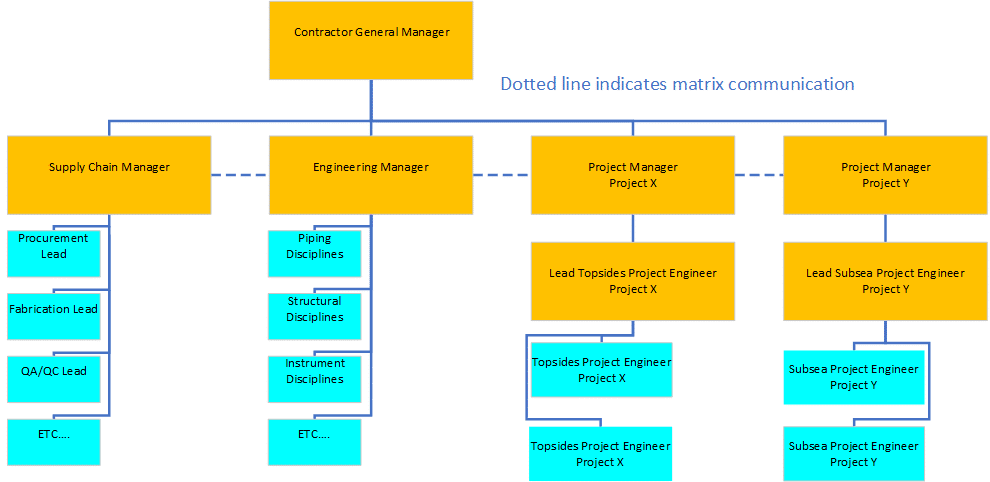The Engineering Disciplines- An Introduction
In this article we will cover the different specialist engineering disciplines, typical organizations, Engineering deliverables, Interface management and finally KANBAN

The Engineering Disciplines
The disciplines, as they are known, are the specialist engineering teams which include but are not limited to :

The list of disciplines above relates to Offshore Oil and Gas/New Energy however many of the specialist disciplines are also involved in many other industries with very similar work processes and deliverables.
As a aspiring or practicing Project Engineer/Manager or Engineering Manager you may come from a range of backgrounds including:
- A discipline engineer with several years of experience.
- Direct entry as a graduate.
- As a Project Engineer/Manager or Engineering Manager from another industry.
- As a subcontractor/supplier engineer.
Whilst you may have expertise in one of the above it is not possible to have expertise in them all. Link to Engineering Disciplines Online course
Discipline engineers normally progress from graduate engineer through various levels of increasing competence and responsibility up to Principal or Lead engineer. As a Project Engineer/Manger you will not be involved in the detailed engineering and calculations that the disciplines do but will have an important role in coordinating their efforts.
As an Engineering Manager you will be accountable for the resourcing of the engineering team, quality of work and ensuring compliance with appropriate internal and external standards.
As the Project Engineer/Manager you will need to have a higher-level view of the overall scope and be able to integrate the efforts of the disciplines. To do this you need to have a sufficient understanding of what each discipline does, their design processes and how they interface with each other.
As an Engineering Manager you will be responsible for the entire engineering team and therefore will require a comprehensive understanding of each discipline.
Tip: When joining a new project the first two documents that I obtain are the structural General Arrangements, GAs, of the facility and the Process Flow Diagrams, PFDs. The structural GA lets me see physically what the installation looks like and the location of the main modules, such as process, utilities, drilling, & accommodation. The PFDs show the facility process at a high level.
Typical Organisations
Typical engineering organograms are shown below for a dedicated project team structure and for a matrix team structure.
Project Organogram

Matrix Organogram

The Engineering Discipline Team
The engineering team will report to the Project Engineer/Project Manager concerning deliverables and scheduled dates. They will also report to the Engineering Manager on technical issues and issues of procedural compliance. The engineering manager is also normally responsible for resourcing the engineering team and up-manning/down-manning as project workload dictates.
Engineering Deliverables and Interfaces Management
The key to a successful project especially during the design phase is effective management of the engineering disciplines. There are a range of techniques available:
- Minutes of meetings.
- Action Logs.
- Deliverables schedules.
- Formal Interface management procedure.
- KANBAN.
Minutes of Meetings
Minutes of meetings with the engineering team are useful to record interfaces and actions in detail. On the downside they take significant time to prepare and update.
Action Logs
Action logs using spreadsheets will not normally provide as much detail as minutes of meeting but are much quicker to update and will allow all completed action history to be maintained but hidden from current view.
Deliverables schedules
Deliverables schedules are lists of what each discipline is required to produce and by when. They are normally part of the engineering plan. When sorted by due date they allow the Project engineer to identify any items that are forecasting late and to focus on resolving any issues associated with their completion. These issues can be technical, resource, priority etc.
Formal Interface Management procedure
Where there are significant complex interfaces, I recommend use of a formal interface procedure using your organisations approved system or generating one yourself.
Each identified interface will have an owner and agreed interface parties. The interface will be fully defined and will include who needs what information, from whom and by when. This normally goes through several iterations before all agree that the interface is complete. The keys to success with interfaces are a structured approach to interface definition, regular updates, and formal final sign off by all the interface parties and the Project engineer.
Sources of interfaces
The main sources of project interfaces are:
- Sub-contractors
- Package vendors
- Area based teams performing scope in different geographical locations.
Interface process
A typical interface process is listed below:
- Develop interface management plan and procedures.
- Identify key interfaces, define deliverables, responsibilities, and dates.
- Summarise interfaces in the Project Interface Management System and extracted registers and reports.
- Review Interface Register at regularly scheduled interface meetings.
- Monitor, Track, Expedite and Report on interface performance and progress.
Interface information
It is suggested that each interface sheet contains the following information:
- Interface Number
- Revision Number
- Revision Date
- Title
- Short Description
- Data Supplier
- Data Receiver
- Required Return Date
- Forecast Delivery Date
- Close-Out Date
- Status
- General Comments
A large project will require a dedicated interface manager/engineer however on smaller projects this will typically be carried out by the Project Engineer.
Engineering Documents Process
Engineering documents/drawings are issued in a rigorously controlled manner by the Document Control Function, (DCC). These departments have bespoke databases that track every document, to whom it was issued, when and at what revision. Although the exact coding for documents varies with each organization the following generic types apply.
Issued for review (IFR): Documents/drawings are issued for review and comment by engineers and subcontractors with comments collated by DCC and returned to the origination engineer to allow revision of the document.
Issued for design (IFD): This is where documents/drawings are sufficiently defined to allow other disciplines to carry out detailed engineering. An example to this is piping and instrument diagrams, (see process chapter),when issued IFD can then be used by piping to develop their detailed layouts.
Issued for Procurement (IFP): This revision allows issue to subcontractors by the procurement team and is usually very well defined, specific in content and unlikely to change.
Issued for construction (IFC): These are documents/drawings that can be included in the offshore or module site construction workpacks and used for reference whilst carrying out the offshore construction.
KANBAN
KANBAN is a visual system adapted from manufacturing for knowledge based work such as projects. The key principles are:
- To map the work process. I.e. engineering process, procurement process etc.
- Populate a visual KANBANboard with cards indicating deliverables etc
- As a team review this regularly, i.e. daily and resolve any pinch points at the daily meeting.
This can be highly effective and really gets the teams working together and supporting each other. I recommend the following book to allow you to get started with KANBAN Theory. Try it! It is very effective. KANBAN in 30 Days.T&J Bjorkholm; ISBN 978-1-78300-090-6.
I have personally implemented KANBAN on a number of projects and it reduces e-mail traffic, encourages immediate short problem solving conversations and improves the team spirit. Check out the following link to our Hybrid Agile Approach
Engineering Disciplines Summary
As a Project Engineer/Manager or Engineering Manager you will only be as good as your engineering team therefore it is incumbent on you to look after them well. What this means is being clear in your requirements, resolving issues and providing information in a concise and timely manner.
The key to managing and supporting the disciplines is communication. This means that you as either a Projects or Engineering Leader taking the time to filter the “noise”, collate and organise information and then output agreed actions and interfaces to the team in an easily usable format.
Link to Engineering Disciplines Online course and other courses
As always comments and feedback welcome. Click here to get in touch
For further resources on the Engineering disciplines follow links to:
The Institution of Mechanical Engineers.


